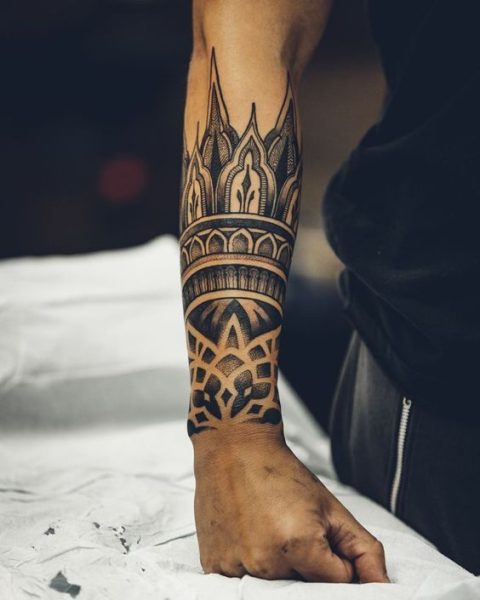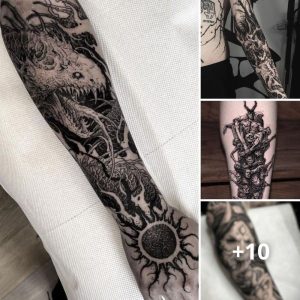
Geometric tattoos have surged in popularity in recent years, with their mesmerizing patterns and clean lines capturing the attention of ink enthusiasts worldwide. But did you know that geometric designs have a history that stretches back millennia, long before they adorned our arms and bodies?
In this article, we will delve into the world of geometric tattoos, tracing their origins, symbolism, and significance. Whether you’re contemplating getting a geometric tattoo or just curious about their rich history, read on to uncover the captivating stories behind these striking body artworks.
The Rise of Geometric Tattoos
Geometric tattoos, characterized by precise lines, shapes, and symmetrical patterns, have experienced a modern resurgence in the world of body art. These designs offer a sense of order and balance, resonating with those who appreciate the aesthetics of mathematics and geometry. However, the roots of geometric tattoos can be traced back to ancient cultures, where they held profound symbolic meanings.
Ancient Geometric Tattoos
Geometric designs have been found on the bodies of ancient mummies and in archaeological discoveries dating back thousands of years. These tattoos were more than just decorative; they carried deep cultural and spiritual significance. Let’s explore the historical contexts of geometric tattoos in some ancient civilizations.

Egyptian Geometric Tattoos:
In ancient Egypt, geometric patterns were widely used as protective symbols and amulets. These tattoos often featured shapes like triangles, circles, and lines, believed to ward off evil spirits and offer protection in the afterlife.
Polynesian Geometric Tattoos:
The Polynesian islands have a rich history of tattooing, and their geometric designs are among the most famous. These tattoos, known as “Tatau,” are steeped in tradition and symbolism. Geometric patterns, often in the form of triangles and lines, represent various aspects of life, including social status, family, and spirituality.
Maori Geometric Tattoos:
The indigenous Maori people of New Zealand are renowned for their striking facial tattoos, or “Moko.” These tattoos often feature intricate geometric designs and serve as a visual record of a person’s ancestry, achievements, and social standing.
Aztec Geometric Tattoos:
The Aztecs of Mesoamerica used geometric designs in their body art. These tattoos were integral to their religious practices, symbolizing their connection to the divine and representing cosmic concepts.
Modern Geometric Tattoos
Today, geometric tattoos have evolved into a versatile and aesthetically pleasing art form. They offer a wide range of design possibilities, from minimalist and subtle patterns to bold, complex creations. These tattoos are often chosen for their modern, clean appearance and their ability to adapt to various body parts, including arms, legs, and chest.

The Geometric Symbolism
Geometric tattoos continue to carry meaning and significance, both in their historical context and in modern interpretations. Here are some common symbolic interpretations associated with geometric tattoo designs:
Balance and Harmony: Geometric tattoos are frequently chosen to represent balance and harmony in life. Symmetry and precise lines are seen as reflections of a well-ordered existence.
Transformation: Geometric shapes such as the Metatron’s Cube or the Flower of Life are symbols of transformation and personal growth. These designs are often associated with spirituality and self-discovery.
Protection: Just as in ancient Egypt, geometric patterns are sometimes chosen to serve as protective talismans. They are believed to guard against negative energies and provide a shield of security.
Unity: Geometric tattoos can symbolize unity and interconnectedness, illustrating how different elements or individuals come together to form a whole.
Choosing the Right Geometric Tattoo
When considering a geometric tattoo, it’s essential to think about the design’s personal significance. Whether you opt for a simple triangle or an intricate sacred geometry pattern, your tattoo should reflect your beliefs, values, or experiences.

Consulting with a professional tattoo artist who specializes in geometric designs is crucial. They can help you refine your ideas, choose the right design, and ensure that the tattoo will harmonize with your body’s contours.
Geometric tattoos, with their rich history and diverse symbolism, have evolved into a compelling art form that resonates with people across cultures and eras. Whether you’re attracted to the clean lines and symmetry of modern geometric tattoos or intrigued by the ancient traditions that inspired them, these tattoos offer a unique canvas for self-expression and a deep connection to the past. The next time you encounter someone with a geometric tattoo on their arm, you’ll know that it’s more than just ink; it’s a story waiting to be told.





